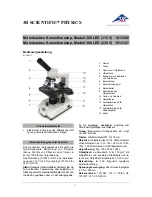
3
Introduction
Scanning process
In a conventional light microscope, object-to-
image transformation takes place simultaneously
and parallel for all object points. By contrast, the
specimen in a confocal LSM is irradiated in a point-
wise fashion, i.e. serially, and the physical inter-
action between the laser light and the specimen
detail irradiated (e.g. fluorescence) is measured
point by point. To obtain information about the
entire specimen, it is necessary to guide the laser
beam across the specimen, or to move the speci-
men relative to the laser beam, a process known
as scanning. Accordingly, confocal systems are
also known as point-probing scanners.
To obtain images of microscopic resolution from a
confocal LSM, a computer and dedicated software
are indispensable.
The descriptions below exclusively cover the point
scanner principle as implemented, for example, in
Carl Zeiss laser scanning microscopes. Configura-
tions in which several object points are irradiated
simultaneously are not considered.
Confocal beam path
The decisive design feature of a confocal LSM
compared with a conventional microscope is the
confocal aperture (usually called pinhole) arranged
in a plane conjugate to the intermediate image
plane and, thus, to the object plane of the micro-
scope. As a result, the detector (PMT) can only
detect light that has passed the pinhole. The pin-
hole diameter is variable; ideally, it is infinitely
small, and thus the detector looks at a point (point
detection).
As the laser beam is focused to a diffraction-limited
spot, which illuminates only a point of the object
at a time, the point illuminated and the point
observed (i.e. image and object points) are situated
in conjugate planes, i.e. they are focused onto
each other. The result is what is called a confocal
beam path (see figure 2).
Pinhole
Depending on the diameter of the pinhole, light
coming from object points outside the focal plane
is more or less obstructed and thus excluded from
detection. As the corresponding object areas are
invisible in the image, the confocal microscope can
be understood as an inherently depth-discriminat-
ing optical system.
By varying the pinhole diameter, the degree of
confocality can be adapted to practical require-
ments. With the aperture fully open, the image is
nonconfocal. As an added advantage, the pinhole
suppresses stray light, which improves image con-
trast.
Fig. 2 Beam path in a confocal LSM. A microscope objective is used to
focus a laser beam onto the specimen, where it excites fluorescence, for
example. The fluorescent radiation is collected by the objective and effi-
ciently directed onto the detector via a dichroic beamsplitter. The interest-
ing wavelength range of the fluorescence spectrum is selected by an emis-
sion filter, which also acts as a barrier blocking the excitation laser line.
The pinhole is arranged in front of the detector, on a plane conjugate to
the focal plane of the objective. Light coming from planes above or below
the focal plane is out of focus when it hits the pinhole, so most of it cannot
pass the pinhole and therefore does not contribute to forming the image.
X
Z
Detector (PMT)
Pinhole
Dichroic mirror
Beam expander
Laser
Microscope objective
Focal plane
Background
Detection volume
Emission filter
337_Zeiss_Grundlagen_e 25.09.2003 16:16 Uhr Seite 6
















































